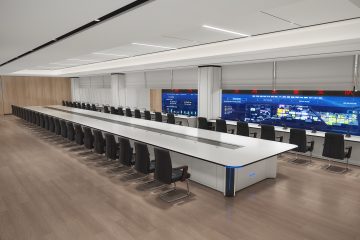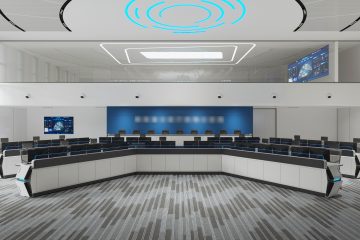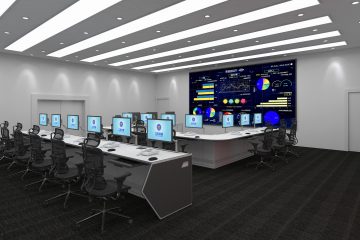Click me to visit our new website

With the rapid advancement of modern technology, control centers play an increasingly vital role in various industries. Whether in traffic management, energy dispatch, security monitoring, or data centers, control centers are the hubs for real-time decision-making, monitoring, and management. At the heart of these operations, control desks, as essential technical furniture, integrate information, optimize workflows, and enhance operational efficiency.
A control desk is not merely a physical platform for staff to perform tasks; it has become the technological centerpiece of a control center by incorporating intelligent design, ergonomics, and integrated technology.
I. Design and Technological Integration of Control Desks
1. Intelligent Design
Modern control desks, compared to traditional workstations, are characterized by their intelligent features. They typically come equipped with multiple displays, touch-sensitive interfaces, and integrated control systems. Through technological integration, operators can seamlessly manage and switch between different data streams, such as surveillance feeds, alarm notifications, and system controls, thereby improving operational efficiency and response times.
Smart control desks can also connect to other devices through Internet of Things (IoT) technology, enabling centralized management. For instance, the desk can coordinate with surveillance systems, communication devices, and even emergency lighting, ensuring that all systems in the control center operate on a unified platform.
2. Ergonomics and Comfort
Since control center tasks often require prolonged monitoring and quick reactions, comfort is crucial for operators. Advanced control desks emphasize ergonomic design, allowing for height adjustments, tilt-angle changes, and free movement of display screens. These features not only enhance the comfort of staff but also reduce the physical strain associated with long-term use.
Many modern control desks also feature memory functions that store individual users’ preferences, such as desk height and screen angles. When operators switch roles, the desk can quickly adjust to their pre-set optimal positions, ensuring maximum efficiency.
II. The Key Role of Control Desks
1. Information Integration and Real-Time Decision Support
One of the primary roles of control desks in control centers is information integration. Through advanced hardware and software systems, control desks present real-time data from multiple sources to operators. For example, an operator in an energy dispatch center can simultaneously monitor power consumption in various regions, emergency alerts, and weather forecasts, making more informed decisions.
These desks often feature multi-screen display systems and split-screen technology, allowing operators to monitor multiple systems simultaneously, reducing reaction times. Control desks can also connect to central databases and intelligent analysis systems, providing real-time data analysis and generating visual reports to help operators make quick judgments and respond to emergencies.
2. Enhancing Collaboration and Communication Efficiency
Teamwork and cross-departmental collaboration are essential in control centers. Through the support of technical furniture, control desks serve not only as individual workstations but also as hubs for coordinated team efforts. Integrated communication systems and instant collaboration tools allow operators in different roles to exchange information in real-time, working together to tackle complex tasks.
Control desks enable operators to quickly share screens, send real-time data, or use voice and video conferencing systems to stay in contact with other departments. This efficient collaboration model improves the overall response speed of the control center, especially in emergency situations where resources must be mobilized and coordinated swiftly.
III. Future Trends in Control Desk Development
1. Intelligent Control and Automated Management
With the development of artificial intelligence (AI) and automation, future control desks will become even more intelligent. By introducing smart assistant systems, control desks will automate routine tasks such as data analysis, system monitoring, and report generation. This allows operators to focus on more strategic and complex tasks, further improving work efficiency.
2. Virtual Reality (VR) and Augmented Reality (AR) Applications
Future control desks may also integrate virtual reality (VR) and augmented reality (AR) technologies to provide more intuitive and immersive operational experiences. For instance, operators could use AR glasses or VR equipment to interact with complex systems in a virtual environment, view 3D models, monitor remote devices, and even collaborate with remote experts in real-time.
3. Eco-Friendly and Sustainable Design
As sustainability becomes increasingly important, future technical furniture will focus more on eco-friendly and sustainable designs. Control desks will use more recyclable materials and adopt energy-saving technologies to reduce power consumption. For example, control desks might integrate solar panels or use energy-efficient displays to minimize environmental impact.
IV. Conclusion
As the core technical furniture in control centers, control desks are not just physical work platforms. By incorporating intelligent design, technological integration, and ergonomic features, they enhance the operational efficiency and response capabilities of control centers. With continuous advancements in technology, the functions and design of control desks will further evolve, becoming indispensable components of future control centers. By optimizing information processing and collaboration mechanisms, control desks will help control centers across various industries operate more efficiently and safely.



0 Comments